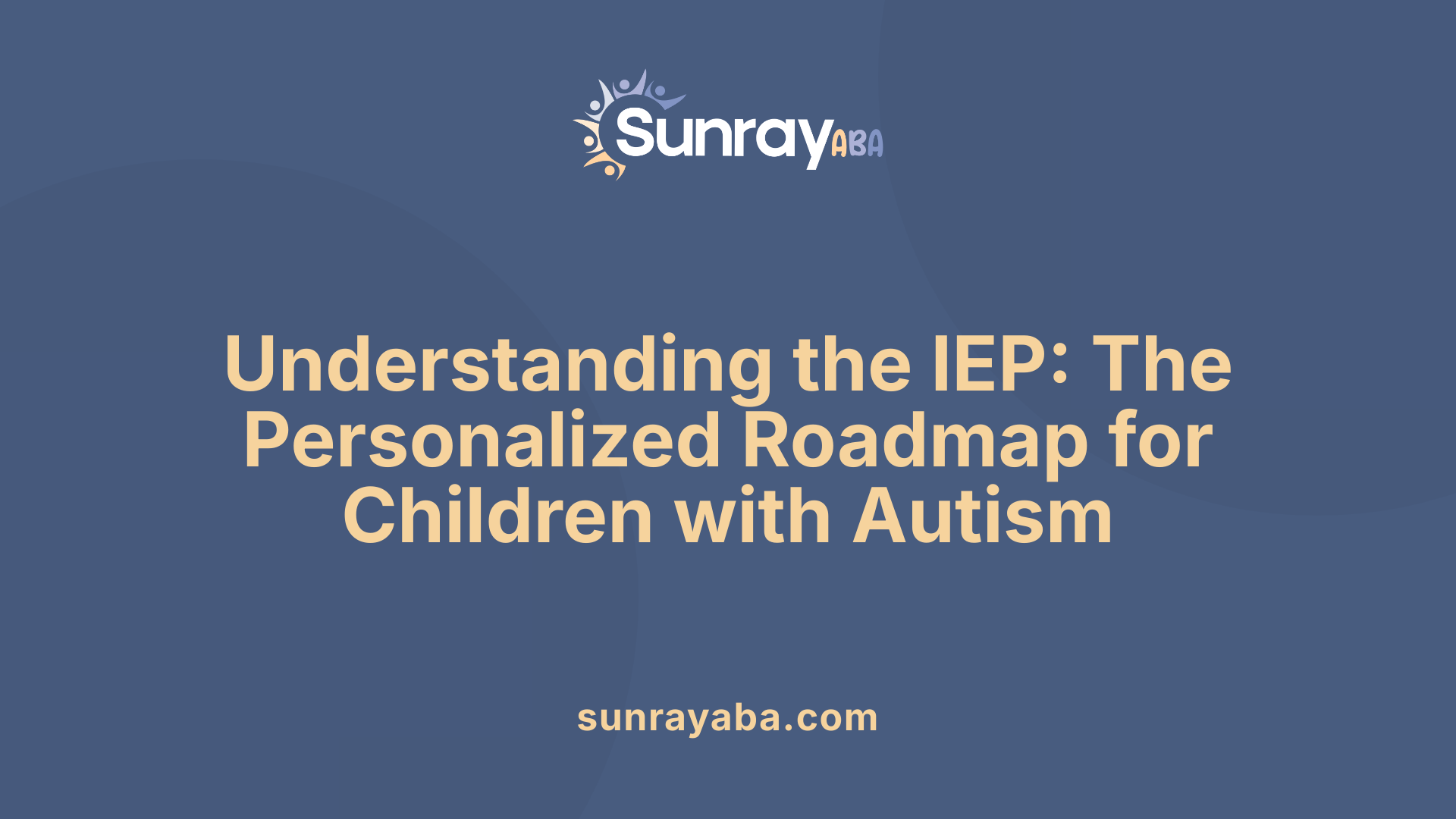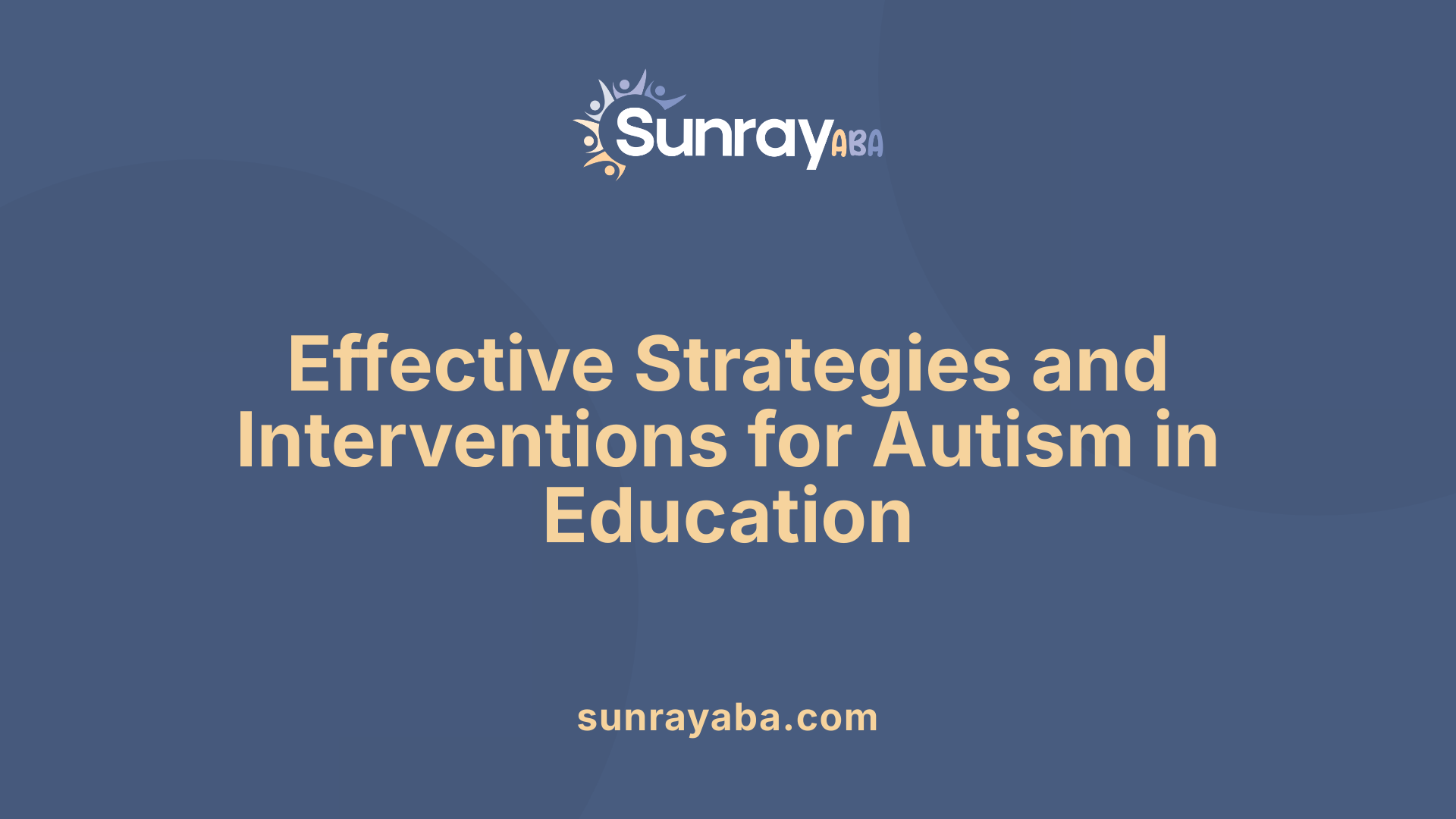Individualized Education Programs (IEPs) for Autism

Understanding IEPs: A Foundation for Support
An Individualized Education Program (IEP) is a crucial legal document that ensures children with autism receive tailored educational services and support. Developed collaboratively by a team of parents, educators, and specialists, an IEP addresses each child's unique strengths and challenges, helping guide their academic, social, and behavioral development. This comprehensive plan not only specifies educational goals and supports but also works as a roadmap for delivering targeted interventions, accommodations, and transition planning, assuring every child’s right to an appropriate public education.
What is an IEP and How Does It Support Children with Autism?

What is an IEP and how does it support children with autism?
An IEP, or Individualized Education Program, is a written plan created specifically for children with autism who need specialized educational support. This legally binding document sets out personalized academic goals, describes the child's learning needs, and details the services and accommodations required to help the child succeed.
The IEP begins with thorough assessments that determine the child's current performance levels and eligibility for special education services under laws like IDEA (Individuals with Disabilities Education Act). Based on these evaluations, the team—comprising parents, teachers, school psychologists, speech therapists, and other specialists—collaboratively develops goals tailored to the child's strengths and challenges.
Components of an IEP
The main parts of an IEP include:
- Present levels of performance: An overview of how the child is currently doing academically, socially, and behaviorally.
- Measurable goals: Clear, achievable objectives focusing on academic skills, social interactions, speech, behavior, or daily living skills.
- Services and supports: Specific interventions such as speech therapy, occupational therapy, social skills training, and behavioral interventions.
- Accommodations: Adjustments like seating arrangements, extended test time, or sensory supports to help the child access the curriculum.
- Placement: The educational setting most appropriate for the child's needs, whether inclusive classrooms or specialized environments.
- Progress monitoring: Regular assessments to track improvements and adjust the plan accordingly.
Support for Academic, Social, and Behavioral Needs
Children with autism benefit from a comprehensive IEP that addresses various aspects of their development. Academically, goals might include reading comprehension, math skills, or functional academics relevant to daily life.
Social goals aim to enhance communication skills, peer interactions, and social understanding. Behavioral goals target reducing self-stimulatory behaviors, increasing adaptive behaviors, and teaching positive behaviors through behavioral interventions.
Services like social skills training, speech and language therapy, and occupational therapy are often part of the plan. The IEP acts as a roadmap, guiding educators and parents to implement tailored strategies that foster both learning and personal growth.
How Does the IEP Support Transition and Evolving Needs?
Most IEPs are reviewed annually, allowing the team to modify goals and services as the child develops. For older children, transition planning prepares them for post-secondary education, employment, and independent living. In this way, the IEP not only supports immediate educational success but also helps the child build skills for future independence.
Overall, an IEP empowers parents, educators, and service providers to work together, ensuring that children with autism receive customized support that promotes their strength and addresses their challenges at every stage of their development.
Legal Rights and Eligibility for Autism Support in Education

What are the legal rights and eligibility criteria for obtaining an IEP for a child with autism?
Children with autism are protected under federal law when it comes to receiving special education services. The Individuals with Disabilities Education Act (IDEA) mandates that eligible students, including those with autism, must be provided with a free appropriate public education (FAPE).
To qualify for an Individualized Education Program (IEP), a child must undergo a comprehensive evaluation conducted by qualified professionals. This assessment examines whether autism-related characteristics—such as difficulties in communication, social interaction, and behavior—adversely affect the child's ability to learn in a typical classroom setting. Importantly, a formal medical diagnosis of autism is not always necessary for eligibility. Instead, the evaluation within the school system determines if the child's learning and functioning are impacted enough to require specialized services.
The criteria for eligibility are consistent across the U.S., following federal regulations outlined in 34 CFR §300.8(c)(1). These regulations ensure that children with disabilities like autism have a right to access educational supports tailored to their needs. After the assessment, the IEP team—comprising parents, educators, and specialists—develops a personalized plan that includes specific goals and support services.
Parents have the right to be involved throughout this process. They can request evaluations, review assessment results, and participate in IEP meetings to advocate for their child's educational needs. If a child is found eligible, the IEP guarantees access to services such as speech therapy, behavioral interventions, and accommodations necessary for success in school.
In summary, children with autism are entitled to an education plan if their condition impacts their learning. The eligibility process emphasizes collaborative assessment and ensures that students receive the tailored support necessary for their educational growth and development.
Developing Effective IEP Goals and Objectives for Autism
How are IEP goals and objectives developed for children on the autism spectrum?
Creating meaningful and effective IEP goals for children with autism involves a collaborative process that includes input from parents, teachers, and relevant specialists such as speech therapists, occupational therapists, and psychologists. The primary foundation for these goals is a thorough assessment of the child's current performance levels, often called the Present Levels of Performance. This assessment helps identify specific strengths and challenges in areas like communication, social interaction, behavior, and academics.
To ensure clarity and focus, goals are written to meet the SMART criteria—Specific, Measurable, Attainable, Relevant, and Time-bound. For example, a goal might specify that the child will improve their spoken language skills to use three-word sentences in structured settings within six months. This precision helps everyone involved understand what success looks like and set realistic benchmarks.
Each goal is tailored to target key developmental areas. Academic goals may include improving reading comprehension; social goals might focus on initiating peer interactions; behavioral objectives could aim to reduce self-stimulatory behaviors. Short-term objectives serve as stepping stones toward these larger goals. They are specific actions or skills, such as increasing opportunities for social engagement or reducing specific behavior problems, that can be observed, measured, and recorded over shorter periods.
Progress monitoring is a crucial part of the goal-setting process. Data collection tools like checklists, frequency charts, or daily logs enable educators and parents to track improvement over time. If progress stalls, the team reviews the goals and objectives, making adjustments as necessary. This ongoing review ensures that the IEP remains responsive to the child's evolving needs and promotes meaningful developmental achievements.
In summary, goal and objective development for children with autism is a personalized, collaborative effort rooted in data and designed to advance the child's abilities across multiple domains. Regular review and adjustment help maintain alignment with the child's growth and promote successful educational outcomes.
Procedures for Developing and Reviewing IEPs

What procedures are involved in developing an IEP for a child with autism?
Creating an Individualized Education Program (IEP) for a child with autism is a detailed process that involves multiple steps and collaboration among various stakeholders.
The first step is an evaluation. Professionals, such as psychologists, speech pathologists, and educators, conduct assessments to determine the child's current abilities, challenges, and eligibility under IDEA. These evaluations help in understanding the child's specific needs and establish a baseline for setting goals.
Following assessment, an IEP team is formed, which generally includes parents or guardians, teachers, school administrators, and specialists. This team reviews the assessment results, discusses the child's strengths and areas needing support, and collaborates to develop the initial IEP draft.
During the IEP meeting, measurable and meaningful goals are set across different domains including academic, behavioral, social, and communication skills. The team also determines the necessary services such as speech therapy, occupational therapy, or behavioral interventions, along with accommodations and modifications to support the child's learning.
Once the draft is completed, it is reviewed and finalized with input from parents for approval. Parental consent is obtained before implementation, ensuring they are actively involved in their child's educational plan.
The IEP does not remain static; it is a living document that must be reviewed regularly. Typically, schools conduct formal reviews at least once a year to monitor progress, reassess the child's needs, and update goals and services accordingly. If the child's needs change significantly or progress is not as expected, the IEP team can convene an additional meeting to modify the plan.
In addition to regular reviews, the IEP includes transition planning for older students, focusing on post-secondary education, employment, and independent living skills.
This whole process underscores the importance of collaboration, ongoing assessment, and flexibility—ensuring that the educational plan adapts to support the child's evolving needs and promotes their success in school and beyond.
Core Components of an Autism-Specific IEP

What components are typically included in an IEP for students with autism?
An IEP designed for children with autism is a comprehensive document that sets the foundation for their educational success. It begins with a thorough assessment of the child's current levels of performance, covering academic skills, social interactions, and behavioral patterns.
Based on these assessments, the IEP includes specific, measurable goals aiming to improve areas such as communication, social skills, behavioral regulation, and academic achievement. These goals are tailored to address each child's unique strengths and challenges.
The plan also details the services required to support the student. This may include speech and language therapy, occupational therapy, social skills training, and specialized instructional strategies. Accommodations like visual supports, flexible seating, or sensory-breaks are also outlined to facilitate learning.
Behavioral interventions are a vital part of many autism IEPs. If problematic behaviors are present, the plan will incorporate a Behavior Intervention Plan (BIP) developed from a Functional Behavior Assessment (FBA). This plan aims to teach alternative behaviors and reduce harmful or disruptive actions.
Furthermore, transition planning becomes essential as students grow older. The IEP will include goals and services that prepare the student for post-secondary life, such as employment, higher education, or independent living.
Finally, the document specifies the child's educational placement, whether in inclusive classrooms, resource rooms, or separate settings, ensuring appropriate access to learning environments.
Access to these components supports a personalized educational approach, helping students with autism thrive academically and socially within the school system.
Effective Educational Strategies and Interventions in Autism IEPs

What are some effective educational strategies and interventions included in IEPs for students with autism?
Children with autism benefit from a variety of tailored educational strategies and interventions outlined in their IEPs. These practices are grounded in evidence-based research and aim to promote learning, social skills, and independence.
One common approach involves the use of visual supports. Visual schedules, picture cards, and visual cues help students understand daily routines, expectations, and transitions. These supports reduce anxiety and enhance comprehension by providing clear, consistent visual information.
Social narratives are another effective tool. These short, personalized stories describe social situations, appropriate responses, and expected behaviors, preparing children for real-life interactions and reducing misunderstandings.
Behavior management techniques such as positive reinforcement and functional behavior assessment (FBA) are crucial. These methods identify the reasons behind behaviors and promote desirable behaviors through rewards and clear expectations, supporting better classroom behavior.
Communication interventions are vital, especially for children with speech and language challenges. Augmentative and alternative communication (AAC) devices, PECS (Picture Exchange Communication System), and video modeling are frequently used to develop and support language and social communication skills.
Naturalistic teaching methods, including Pivotal Response Training (PRT) and peer-mediated interventions, emphasize teaching skills in real-world contexts and involve peers to foster social interaction. These approaches make learning more engaging and meaningful.
Sensory supports are also integrated into IEPs to help manage sensory processing challenges. These may include sensory breaks, calming tools, and sensory-friendly environments that enable children to regulate their sensory input and maintain focus.
Structured routines, clear expectations, and the use of assistive technologies further personalize the learning experience. These tools help address individual sensory and cognitive needs, encouraging participation, reducing challenging behaviors, and fostering independence.
By combining these strategies within the IEP framework, educators can create an inclusive, supportive environment that caters to the unique strengths and needs of students with autism, supporting their academic and social development.
Advocacy and Transition Planning for Autism IEPs
How can parents and caregivers advocate for their child’s IEP services and supports?
Parents and caregivers play a crucial role in ensuring their child receives a quality, tailored education through the IEP process. A strong advocate understands the child's legal rights under laws such as IDEA, Section 504, and ADA, which protect access to special education and supports.
Preparation is vital. Parents should review evaluations and come to meetings with a list of questions and concerns. Requesting draft copies of the IEP beforehand allows for review and thoughtful discussion. It’s also helpful to ask for pre-meetings with school staff to clarify goals and procedures.
Engaging the support of specialized advocates can provide extra guidance. When choosing an advocate, consider their experience, knowledge of education law, and ability to communicate effectively. A qualified advocate can help navigate complex systems and ensure the child's needs are prioritized.
Building open, respectful communication with teachers, administrators, and other professionals fosters collaboration. Parents should advocate persistently by staying involved, attending all meetings, and following up on action items.
Understanding procedural safeguards—such as the right to appeal decisions or request evaluations—empowers parents to effectively stand up for their child's needs. Consistent involvement and clear communication help ensure that the IEP supports the child's academic, social, and behavioral growth, making a meaningful difference in their educational experience.
Role of advocates
Advocates serve as a bridge between families and schools, helping parents understand their rights and options. They assist in preparing for meetings, interpreting evaluations, and negotiating services. Selecting an advocate with relevant experience can make the process smoother and more effective.
Transition planning for adolescents
Transition planning is essential for preparing older students with autism for post-secondary life. This process involves setting goals related to higher education, employment, and independent living.
Most adolescents with ASD have an IEP that includes a transition plan, which begins as early as age 14 in many states. These plans outline specific, measurable objectives that help students develop skills for adulthood.
Effective transition planning may include goals like improving social communication, exploring career interests, or developing daily living skills. It also incorporates services such as vocational training, social skills instruction, and independent living support.
Regular review of transition goals ensures students receive the appropriate services and support as they grow. Engaging students actively in their transition plans fosters self-advocacy and helps them prepare for successful futures.
Ensuring Success Through Collaboration and Ongoing Support
The development and implementation of effective IEPs are fundamental to supporting children with autism in their educational journey. By understanding legal rights, engaging in the collaborative process, setting meaningful goals, and advocating proactively, parents and educators can create a supportive environment tailored to the child’s evolving needs. Transition planning and regular reviews ensure that these plans remain relevant and effective, helping students transition smoothly into adulthood. Resources like advocacy tools, expert insights, and research-backed strategies serve as vital supports, empowering families and educators alike. Ultimately, fostering a child-centered, flexible, and responsive approach to IEP development nurtures the potential for every child with autism to succeed academically, socially, and personally.
References
- Guide to Individualized Education Programs (IEP) - Autism Speaks
- Individualized Education Programs (IEPs) for Autism - WebMD
- Understanding the IEP for Children with Autism
- Top 5 Individualized Education Programs (IEP) Questions
- Individualized Education Programs and Transition Planning for ...
- Individualized Education Programs (IEPs) | Nemours KidsHealth
- [PDF] Individualized Education Programs (IEPs) - JCC of Central New Jersey
- A Guide to IEPs for Autism - One size does not fit all